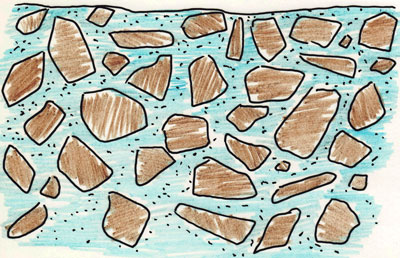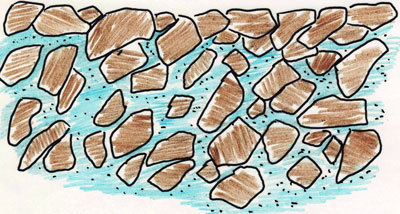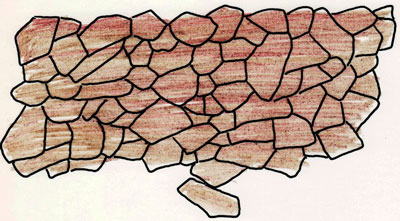Drying and Firing
5 posters
Page 1 of 1
 Drying and Firing
Drying and Firing
Drying of a Pot
After potting the water must be removed from the still wet pot. A faulty drying process can destroy the pot while drying or during the first firing process.

Mechanically bound water fills the space between the single clay particles (this makes the clay homogenous, the clay particles swim).

Physically and chemically bound water envelops the clay particles with a thin surface. This water disappears only after a longer drying process (the clay particles close ranks).

Chemically bound water can not be removed by drying. Only at a firing temperature of 500 degrees this water is also removed (the clay particles then close ranks completely).
The drying of a pot ist very individual and depends on many factors, for example moist or dry weather, summer or winter, windy or windless, warm or cold. All these factors change the drying conditions even in the house. According to this every potter has to find out his own drying technique. Pots wich are made and well dried but not fired already are called “green ware”.
Firing of a Pot
BISQUE FIRING is the first preparation firing process for raw and unglazed ware. This firing process takes place at approximately 800 to 900 degrees.
TERRACOTTA - (derives from the Italian terra cotta - fired earth) the firing temperature is about 800 to 950 degrees. At this temperatures chimney pipes, bricks and flower pots are made. A large amount of pottery ware is fired this way, for example predominantly in mediterranean countries and in Africa.
Advantage: the low commodity price, low and only one time firing and the porosity of the material which is a special advantage for plant containers.
Disadvantage: the seepage of limescale, the handling, easy breaking and that it is not frost-resistant (visible and high porosity).
EARTHENWARE FIRING - the firing temperatures reach between 900 and 1100 degrees (hard earthenware is very near to stoneware, depending on the clay sort and the firing temperature, most Asian bonsai pots are fired like this). Earthenware is glazed in nearly all cases, meant for daily use or for making it watertight. There are very fine earthenware glazes.
Advantage: the firing is quite cheap, the porosity of the material only marginal but still good for bonsai. Disadvantage: only limited frost-resistance, not very shock-proof, limescale seepage can occur.
STONEWARE - the firing temperatures go up to 1200 and 1300 degrees (fine stoneware is fired at about 1300 degrees and is very close to porcelain). Objects made of coarse stoneware are among others canalisation pipes, sanitary devices, tiles, containers and pots. Stoneware is sintered glass-hard and frost-resistant. Many european bonsai potters use this firing technique. At about 1250 degrees the most beautiful glazes are achieved.
Advantage: the pots are absolutely frost-resistant, handling is optimal, no great danger of breaking, very nice glazes, no limescale seepage, fine surface patina.
Disadvantage: The pots are more expensive because auf the high firing costs. They are not perfect for bonsai from the horticultural view. But the optical fine surface, the excellen
handling and frost-resistance should have priority in the choice of pots.
PORCELAIN - the firing temperatures are between 1280 and 1500 degrees (soft porcelain, Asian or English bone china and soft paste china up to 1300 degrees. European hard porcelain is fired at 1350 to 1500 degrees). China is regarded as the cradle of porcelain. It came to Europe over Palestine during the crusades. Marco Polo took Chinese porcelain to Europe about the year 1295 (see also the section “White Gold” on my website).
Advantage: the pots are absolutely frost-resistant, handling is quite good, radiant glazes, no limescale seepage. Very nice for accent bonsai as a contrast to the main tree.
Disadvantage: Porcelain pots are limited in their usefulness for bonsai because they are often visually too feminine. From horticultural considerations they are not very appropriate because they are not porous.
Peter Krebs
Drawings: Peter Krebs
Translation: Heike van Gunst
Best regards
Peter
After potting the water must be removed from the still wet pot. A faulty drying process can destroy the pot while drying or during the first firing process.

Mechanically bound water fills the space between the single clay particles (this makes the clay homogenous, the clay particles swim).

Physically and chemically bound water envelops the clay particles with a thin surface. This water disappears only after a longer drying process (the clay particles close ranks).

Chemically bound water can not be removed by drying. Only at a firing temperature of 500 degrees this water is also removed (the clay particles then close ranks completely).
The drying of a pot ist very individual and depends on many factors, for example moist or dry weather, summer or winter, windy or windless, warm or cold. All these factors change the drying conditions even in the house. According to this every potter has to find out his own drying technique. Pots wich are made and well dried but not fired already are called “green ware”.
Firing of a Pot
BISQUE FIRING is the first preparation firing process for raw and unglazed ware. This firing process takes place at approximately 800 to 900 degrees.
TERRACOTTA - (derives from the Italian terra cotta - fired earth) the firing temperature is about 800 to 950 degrees. At this temperatures chimney pipes, bricks and flower pots are made. A large amount of pottery ware is fired this way, for example predominantly in mediterranean countries and in Africa.
Advantage: the low commodity price, low and only one time firing and the porosity of the material which is a special advantage for plant containers.
Disadvantage: the seepage of limescale, the handling, easy breaking and that it is not frost-resistant (visible and high porosity).
EARTHENWARE FIRING - the firing temperatures reach between 900 and 1100 degrees (hard earthenware is very near to stoneware, depending on the clay sort and the firing temperature, most Asian bonsai pots are fired like this). Earthenware is glazed in nearly all cases, meant for daily use or for making it watertight. There are very fine earthenware glazes.
Advantage: the firing is quite cheap, the porosity of the material only marginal but still good for bonsai. Disadvantage: only limited frost-resistance, not very shock-proof, limescale seepage can occur.
STONEWARE - the firing temperatures go up to 1200 and 1300 degrees (fine stoneware is fired at about 1300 degrees and is very close to porcelain). Objects made of coarse stoneware are among others canalisation pipes, sanitary devices, tiles, containers and pots. Stoneware is sintered glass-hard and frost-resistant. Many european bonsai potters use this firing technique. At about 1250 degrees the most beautiful glazes are achieved.
Advantage: the pots are absolutely frost-resistant, handling is optimal, no great danger of breaking, very nice glazes, no limescale seepage, fine surface patina.
Disadvantage: The pots are more expensive because auf the high firing costs. They are not perfect for bonsai from the horticultural view. But the optical fine surface, the excellen
handling and frost-resistance should have priority in the choice of pots.
PORCELAIN - the firing temperatures are between 1280 and 1500 degrees (soft porcelain, Asian or English bone china and soft paste china up to 1300 degrees. European hard porcelain is fired at 1350 to 1500 degrees). China is regarded as the cradle of porcelain. It came to Europe over Palestine during the crusades. Marco Polo took Chinese porcelain to Europe about the year 1295 (see also the section “White Gold” on my website).
Advantage: the pots are absolutely frost-resistant, handling is quite good, radiant glazes, no limescale seepage. Very nice for accent bonsai as a contrast to the main tree.
Disadvantage: Porcelain pots are limited in their usefulness for bonsai because they are often visually too feminine. From horticultural considerations they are not very appropriate because they are not porous.
Peter Krebs
Drawings: Peter Krebs
Translation: Heike van Gunst
Best regards
Peter

peter krebs- Member
 Re: Drying and Firing
Re: Drying and Firing
I echo the thanks already posted. We also appreciate the care you have taken in providing your own drawings and a very good translation. Well done Peter and Heike! 

Kev Bailey- Admin
 Similar topics
Similar topics» New firing
» my pots - wood firing
» 5th wood firing
» From the Stone Monkey Kiln
» big pots -how to dry. Please help me.
» my pots - wood firing
» 5th wood firing
» From the Stone Monkey Kiln
» big pots -how to dry. Please help me.
Page 1 of 1
Permissions in this forum:
You cannot reply to topics in this forum







